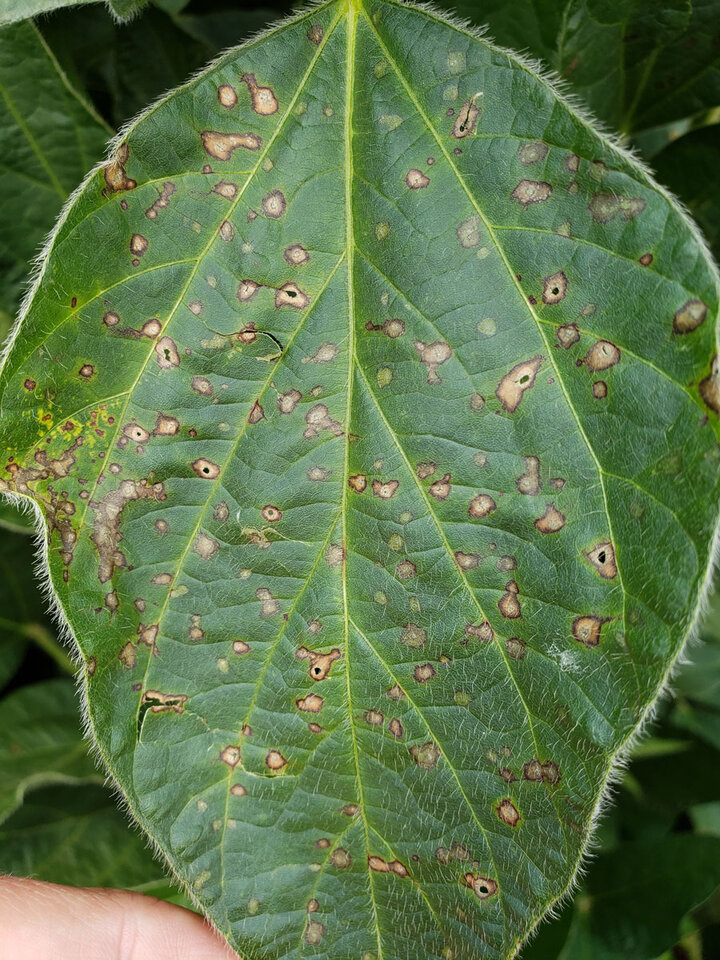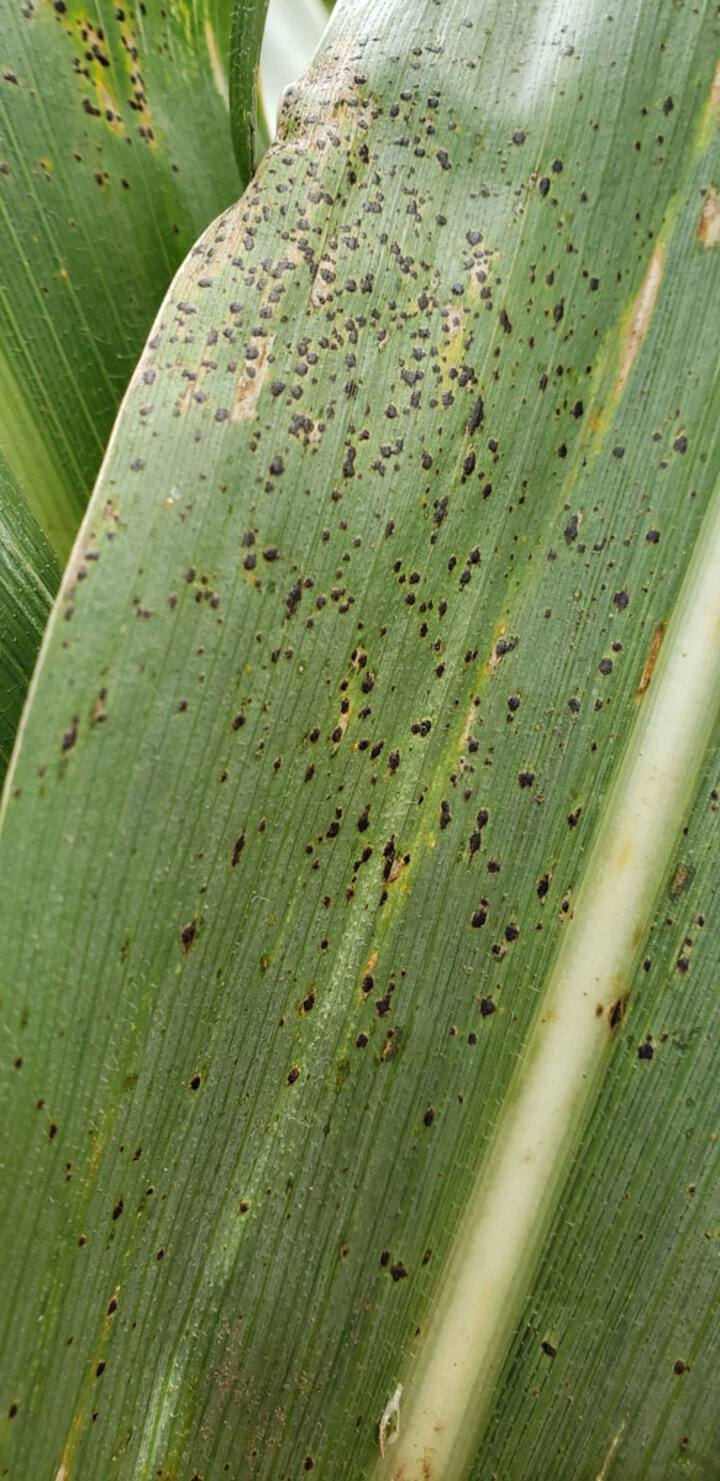Fungicide resistance was confirmed in soybean samples from 10 Nebraska counties infected with the frogeye leaf spot pathogen. Tar spot, a fungal disease of corn, has been confirmed in numerous western Iowa counties and is likely to reach Nebraska in 2020. More information is below, as well as in the Soybean Disease Update and the Corn Disease Update in these Crop Production Clinics eProceedings articles and presentations. A new table was added to the Disease Management section of the 2020 Guide for Weed, Disease, and Insect Management in Nebraska listing products labeled for disease management in alfalfa. Several new products are available for disease management in several crops, including foliar fungicides with active ingredients representing 3 modes of action and an additional seed treatment labeled for use in soybean.
Frogeye Leaf Spot of Soybean
The fungal disease of soybean, frogeye leaf spot (Figure 1), is caused by the fungus Cercospora sojina. Early disease onset that becomes severe can lead to yield loss of up to 35%. Favorable weather conditions and other factors have led to increased disease severity in some areas. In 2019, clientele reported unsatisfactory control of the disease with some foliar fungicide applications. Soybean leaf samples were collected from 10 Nebraska counties and isolates of the fungus were tested for fungicide sensitivity. Out of 113 total C. sojina isolates, 98% (111 isolates) were resistant to the common QoI (formerly strobilurin) fungicides. Resistance was confirmed in all 10 of the counties sampled. Samples were not randomly collected and may not be widely representative of the C. sojina populations in the soybean fields in those counties. However, similar results have been reported in Iowa populations of C. sojina. It is important to avoid the application of QoI fungicides alone on soybean fields with frogeye leaf spot to avoid additional selection pressure that drives fungicide resistance. Management of frogeye leaf spot with fungicides should be with active ingredients representing two or three modes of action and at the labeled rates. Use of a combination of disease management strategies are likely to provide more favorable results, especially the use of frogeye leaf spot resistant soybean varieties, crop rotation, and foliar fungicides, as needed.

Tar Spot of Corn:
Tar spot of corn is likely to be confirmed in Nebraska in 2020. Symptoms of tar spot look like splattered tar or black paint on the leaf. The black “dots” are the fungal reproductive structures, called ascomata, that are raised above the leaf surface and contain hundreds of spores. Ascomata may appear on the leaves or the husks, or leaf sheaths (Figure 2). Ascomata may sometimes be surrounded by tan to brown lesion borders and are called “fisheye” lesions (Figure 3). These structures may be commonly confused with insect frass, but fungal ascomata can’t be rubbed off with the fingers. Tar spot ascomata may also be confused with the black teliospores that are produced by the common rust and southern rust fungi near the end of the growing season. However, teliospores may be rubbed off onto fingers and examination of pustules with a hand lens indicate that they were produced by erupting through the leaf surface instead of developing on it. Foliar fungicides are likely to provide the most effective management of the disease and application timing may be important for satisfactory control.
Identification of tar spot on a corn (or other grass host) sample and shading a county in Nebraska requires submission of a sample to the UNL Plant & Pest Diagnostic Clinic for confirmation. If you need help identifying a disease or think you may have found tar spot, please notify us and submit a sample to the UNL Plant and Pest Diagnostic Clinic.


Changes to the Disease Management section of the 2020 Guide for Weed, Disease, and Insect Management in Nebraska:
New fungicide efficacy tables were added for corn, soybean, and wheat. A new table was added to the Disease Management section summarizing the products available for use in alfalfa. New products were added and are summarized below in Tables 1 and 2.
| Trade Name | Active Ingredient(s) | Fungicide Class(es) | Change(s) Made |
|---|---|---|---|
| Saltro | Pydiflumetofen 41.7% | SDHI (Group 7) | Added to the soybean table for seed treatment products for disease management |
| Trade Name | Active Ingredient(s) | Fungicide Class(es) | Change(s) Made |
|---|---|---|---|
| Lucento | Flutriafol 26.5% + Bixafen 15.6% |
Mixed Modes of Action (Groups 3 + 7) |
Added to corn, sorghum, soybean, and wheat tables for foliar disease management |
| Miravis Ace | Propiconazole 11.4% Pydiflumetofen 13.7% |
Mixed Modes of Action (Groups 3 + 7) |
Added to wheat table for foliar disease management |
| Miravis Neo | Propiconazole 11.6% Pydiflumetofen 7.0% Azoxystrobin 9.3% |
Mixed Modes of Action (Groups 3 + 7 + 11) |
Added to corn and soybean tables for foliar disease management |
| Revytek | Mefentrifluconazole 11.61% Pyraclostrobin 15.49% Fluxapyroxad 7.74% |
Mixed Modes of Action (Groups 3 + 7 + 11) |
Added to corn and soybean tables for foliar disease management |
| Veltyma | Mefentrifluconazole 17.56% Pyraclostrobin 17.56% |
Mixed Modes of Action (Groups 3 + 11) |
Added to corn, potato, soybean, sugar beet tables for foliar disease management |
